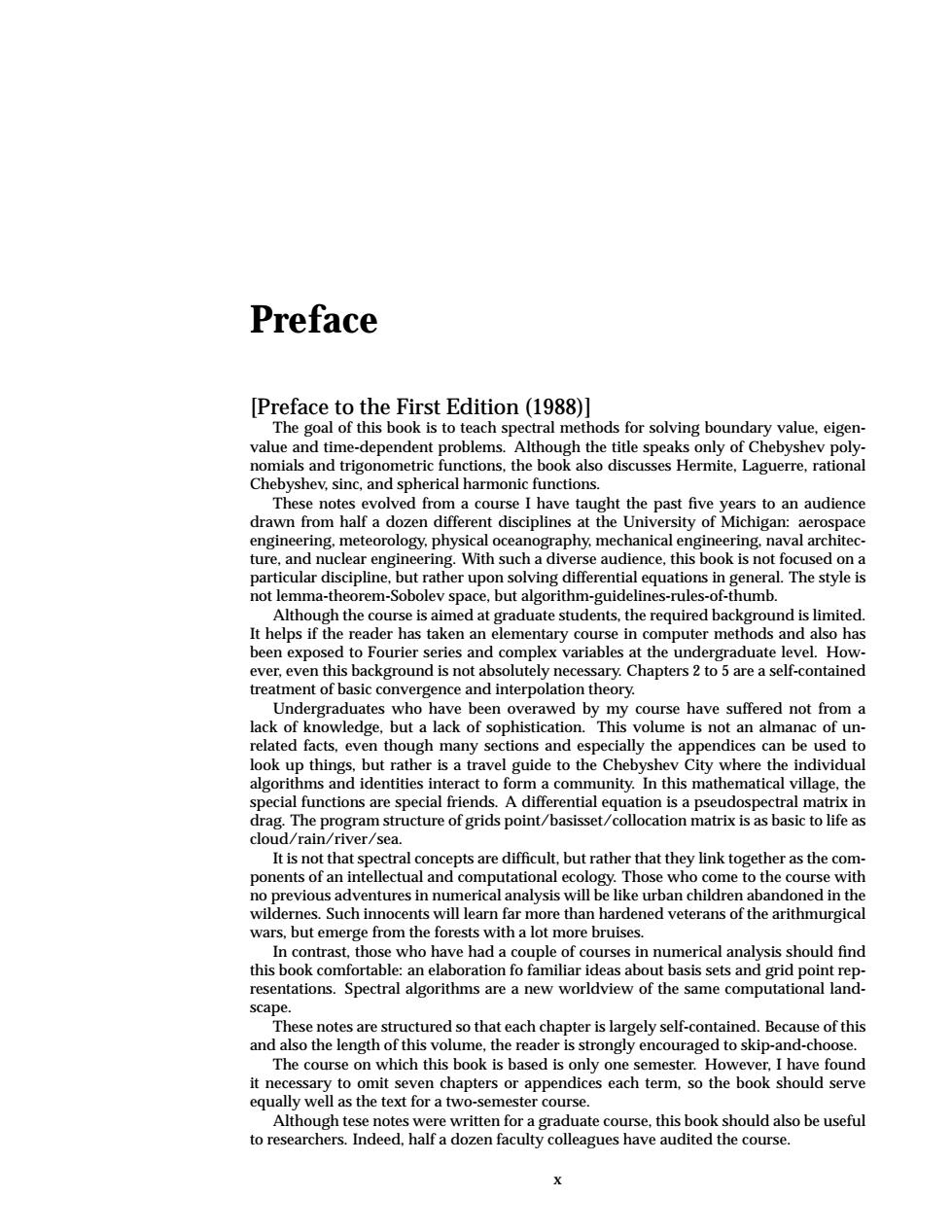正在加载图片...

Preface [Preface to the First Edition (1988)] The goal of this book is to teach spectral methods for solving boundary value,eigen- value and time-dependent problems.Although the title speaks only of Chebyshev poly- nomials and trigonometric functions,the book also discusses Hermite,Laguerre,rational Chebyshev,sinc,and spherical harmonic functions. These notes evolved from a course I have taught the past five years to an audience drawn from half a dozen different disciplines at the University of Michigan:aerospace engineering.meteorology,physical oceanography,mechanical engineering,naval architec- ture,and nuclear engineering.With such a diverse audience,this book is not focused on a particular discipline,but rather upon solving differential equations in general.The style is not lemma-theorem-Sobolev space,but algorithm-guidelines-rules-of-thumb. Although the course is aimed at graduate students,the required background is limited. It helps if the reader has taken an elementary course in computer methods and also has been exposed to Fourier series and complex variables at the undergraduate level.How- ever,even this background is not absolutely necessary.Chapters 2 to 5 are a self-contained treatment of basic convergence and interpolation theory. Undergraduates who have been overawed by my course have suffered not from a lack of knowledge,but a lack of sophistication.This volume is not an almanac of un- related facts,even though many sections and especially the appendices can be used to look up things,but rather is a travel guide to the Chebyshev City where the individual algorithms and identities interact to form a community.In this mathematical village,the special functions are special friends.A differential equation is a pseudospectral matrix in drag.The program structure of grids point/basisset/collocation matrix is as basic to life as cloud/rain/river/sea. It is not that spectral concepts are difficult,but rather that they link together as the com- ponents of an intellectual and computational ecology.Those who come to the course with no previous adventures in numerical analysis will be like urban children abandoned in the wildernes.Such innocents will learn far more than hardened veterans of the arithmurgical wars,but emerge from the forests with a lot more bruises. In contrast,those who have had a couple of courses in numerical analysis should find this book comfortable:an elaboration fo familiar ideas about basis sets and grid point rep- resentations.Spectral algorithms are a new worldview of the same computational land- scape. These notes are structured so that each chapter is largely self-contained.Because of this and also the length of this volume,the reader is strongly encouraged to skip-and-choose. The course on which this book is based is only one semester.However,I have found it necessary to omit seven chapters or appendices each term,so the book should serve equally well as the text for a two-semester course. Although tese notes were written for a graduate course,this book should also be useful to researchers.Indeed,half a dozen faculty colleagues have audited the course. XPreface [Preface to the First Edition (1988)] The goal of this book is to teach spectral methods for solving boundary value, eigenvalue and time-dependent problems. Although the title speaks only of Chebyshev polynomials and trigonometric functions, the book also discusses Hermite, Laguerre, rational Chebyshev, sinc, and spherical harmonic functions. These notes evolved from a course I have taught the past five years to an audience drawn from half a dozen different disciplines at the University of Michigan: aerospace engineering, meteorology, physical oceanography, mechanical engineering, naval architecture, and nuclear engineering. With such a diverse audience, this book is not focused on a particular discipline, but rather upon solving differential equations in general. The style is not lemma-theorem-Sobolev space, but algorithm-guidelines-rules-of-thumb. Although the course is aimed at graduate students, the required background is limited. It helps if the reader has taken an elementary course in computer methods and also has been exposed to Fourier series and complex variables at the undergraduate level. However, even this background is not absolutely necessary. Chapters 2 to 5 are a self-contained treatment of basic convergence and interpolation theory. Undergraduates who have been overawed by my course have suffered not from a lack of knowledge, but a lack of sophistication. This volume is not an almanac of unrelated facts, even though many sections and especially the appendices can be used to look up things, but rather is a travel guide to the Chebyshev City where the individual algorithms and identities interact to form a community. In this mathematical village, the special functions are special friends. A differential equation is a pseudospectral matrix in drag. The program structure of grids point/basisset/collocation matrix is as basic to life as cloud/rain/river/sea. It is not that spectral concepts are difficult, but rather that they link together as the components of an intellectual and computational ecology. Those who come to the course with no previous adventures in numerical analysis will be like urban children abandoned in the wildernes. Such innocents will learn far more than hardened veterans of the arithmurgical wars, but emerge from the forests with a lot more bruises. In contrast, those who have had a couple of courses in numerical analysis should find this book comfortable: an elaboration fo familiar ideas about basis sets and grid point representations. Spectral algorithms are a new worldview of the same computational landscape. These notes are structured so that each chapter is largely self-contained. Because of this and also the length of this volume, the reader is strongly encouraged to skip-and-choose. The course on which this book is based is only one semester. However, I have found it necessary to omit seven chapters or appendices each term, so the book should serve equally well as the text for a two-semester course. Although tese notes were written for a graduate course, this book should also be useful to researchers. Indeed, half a dozen faculty colleagues have audited the course. x